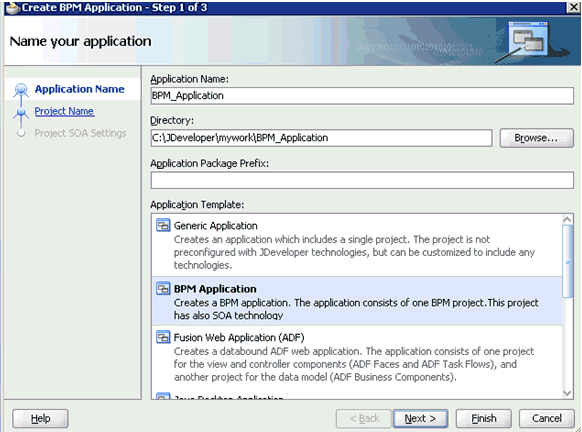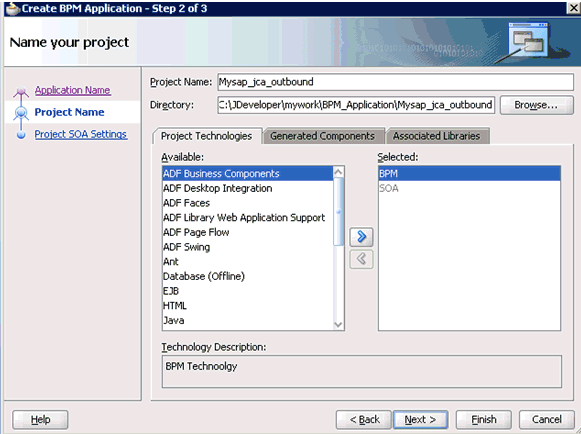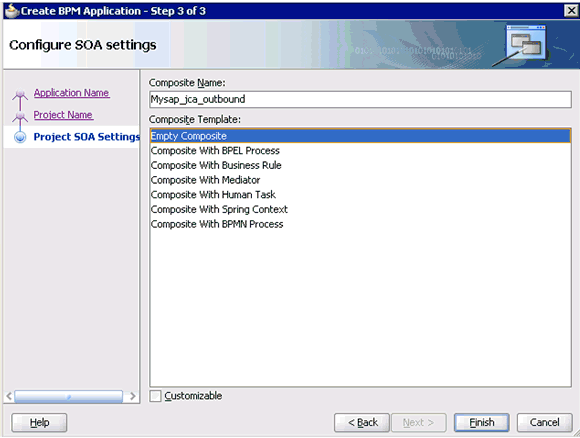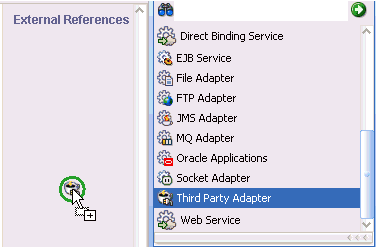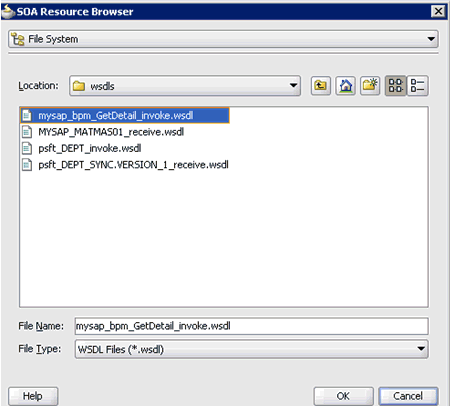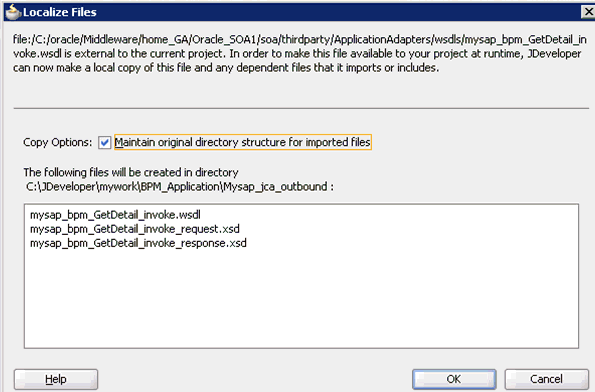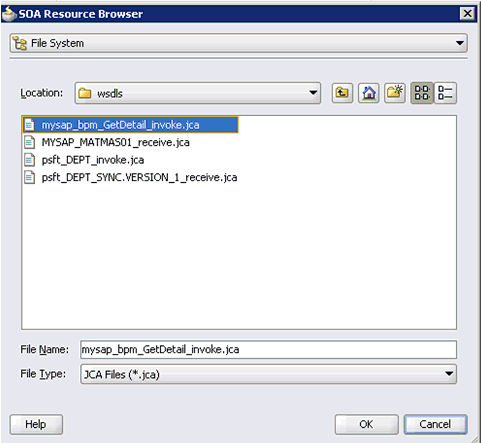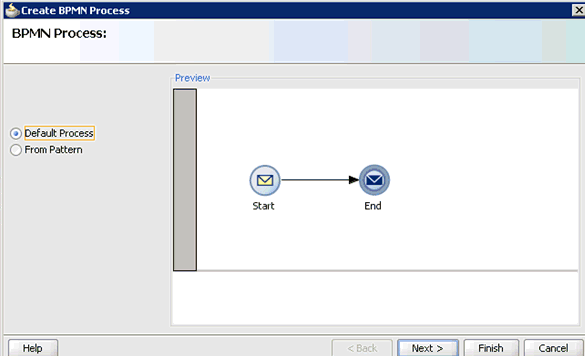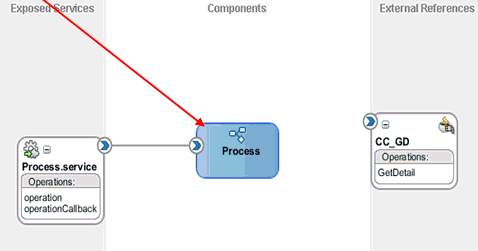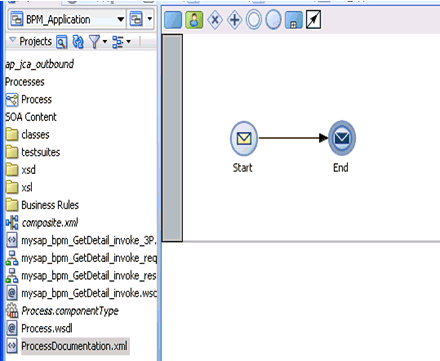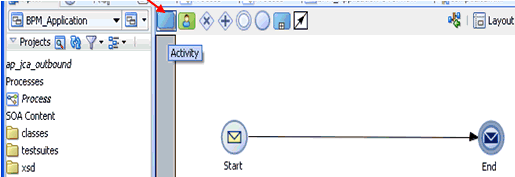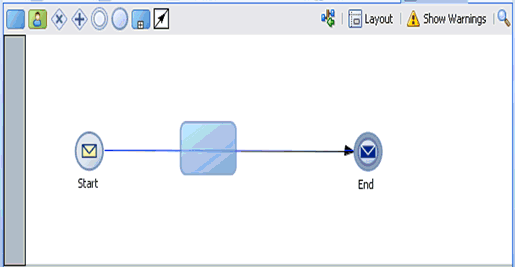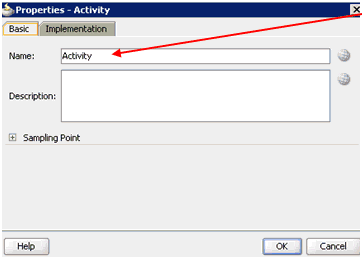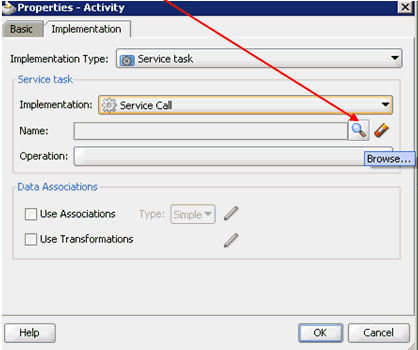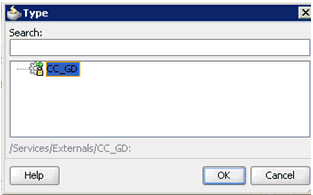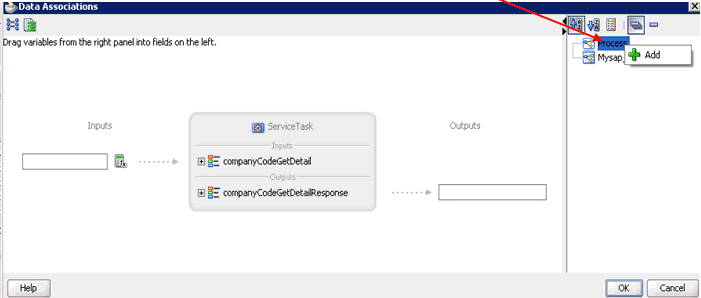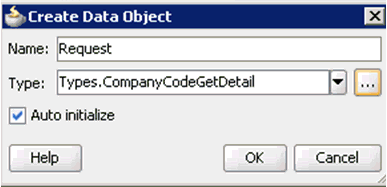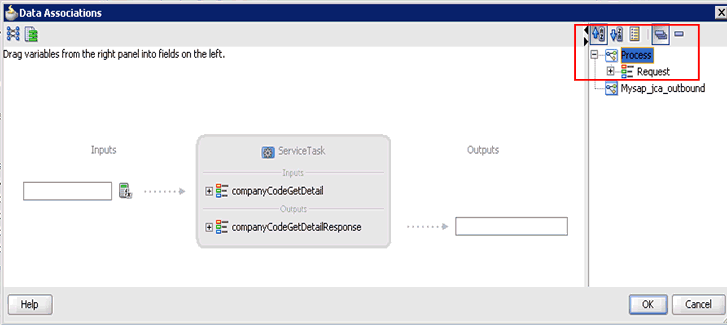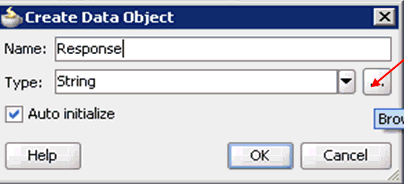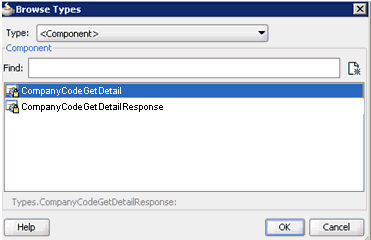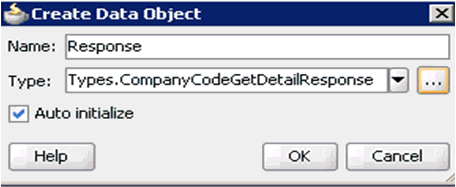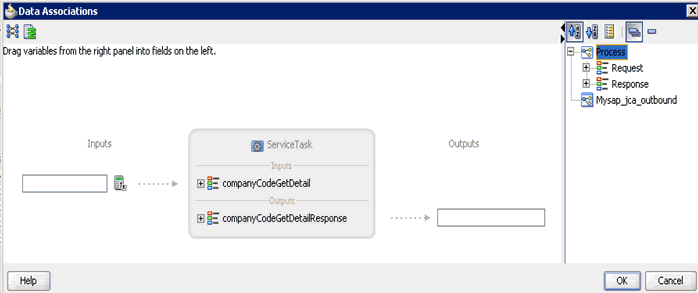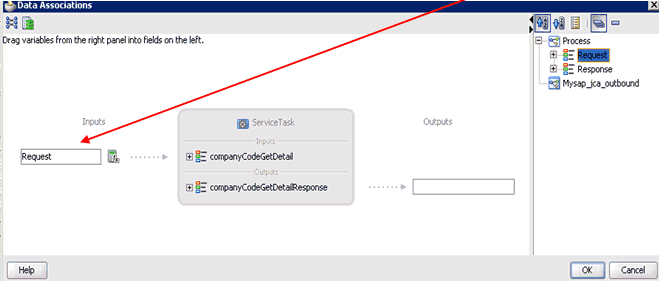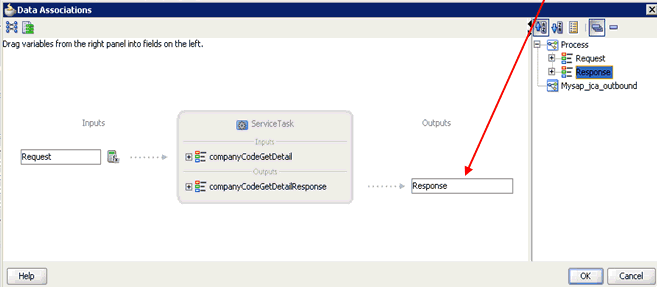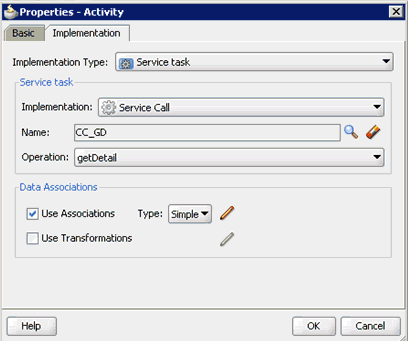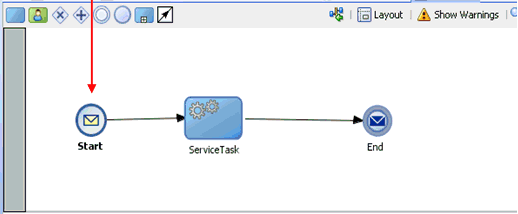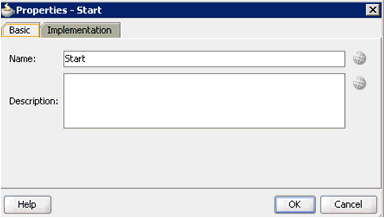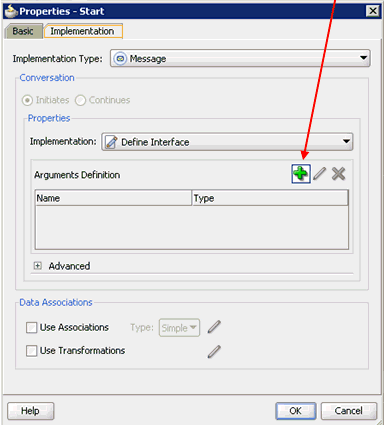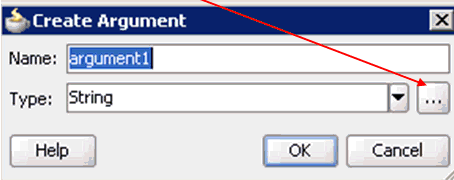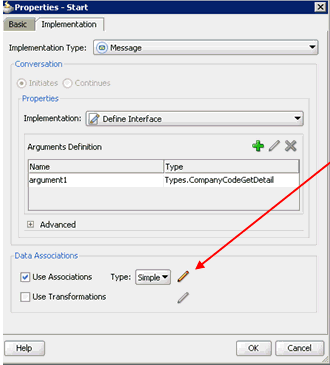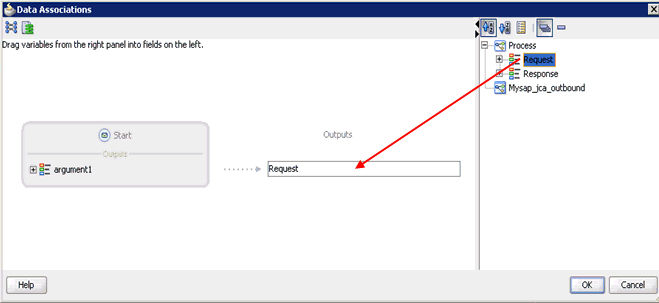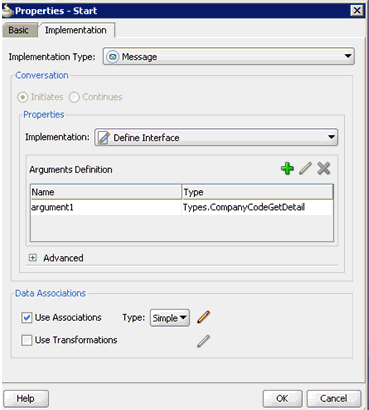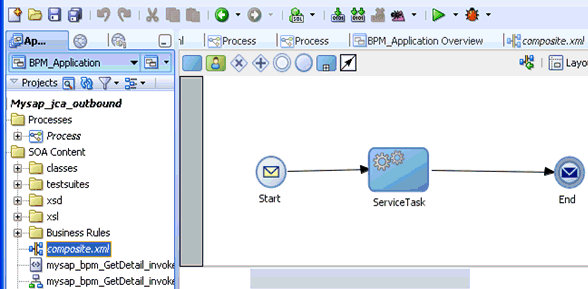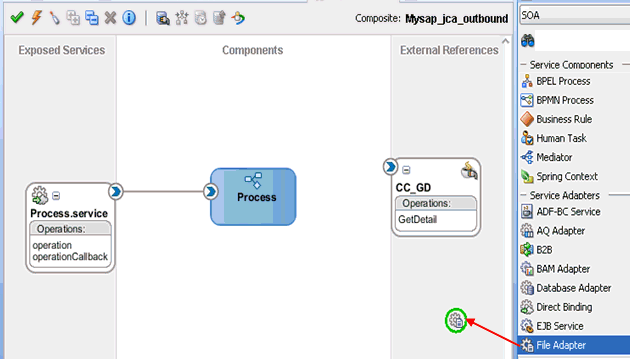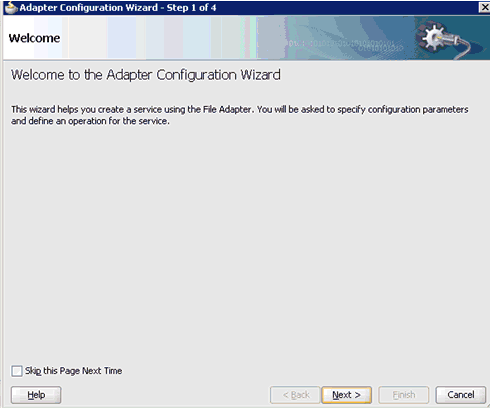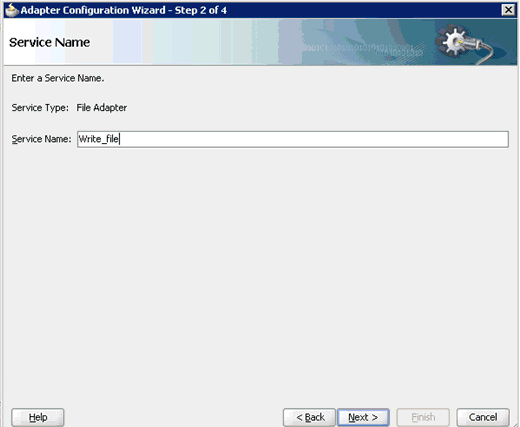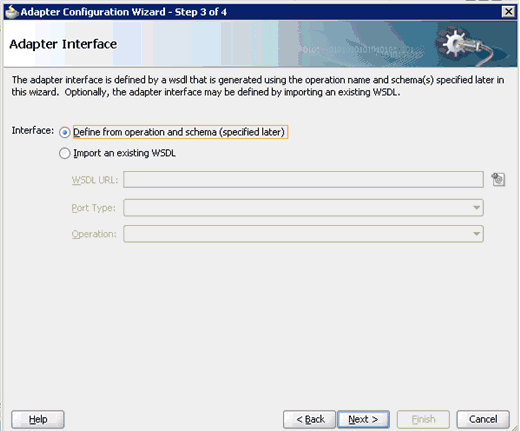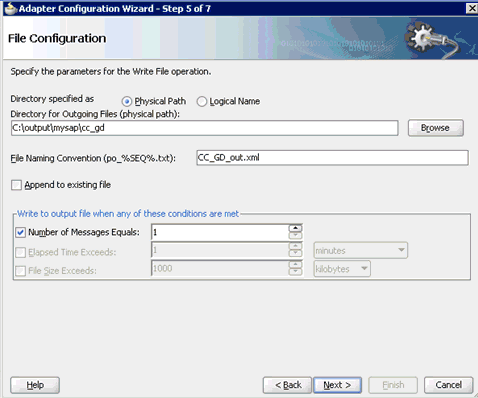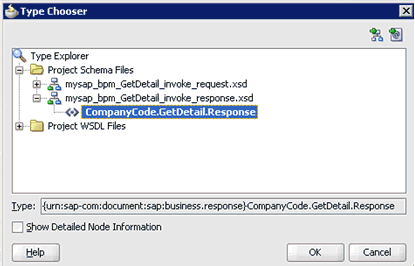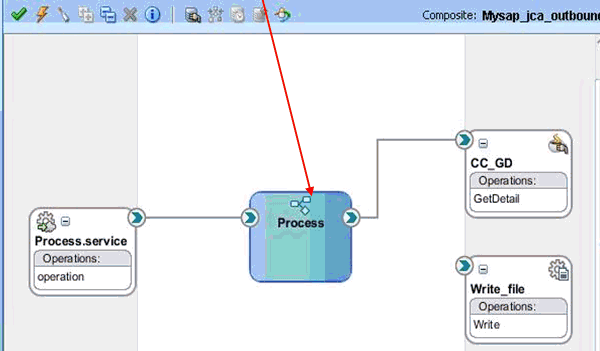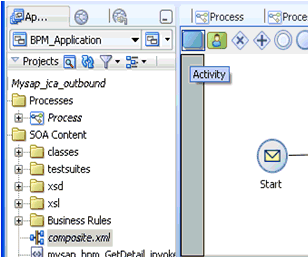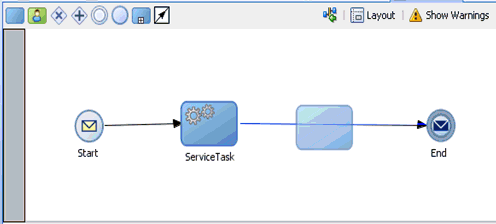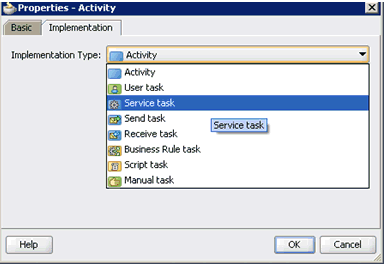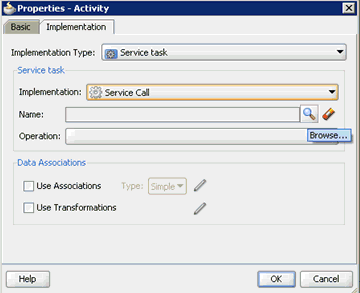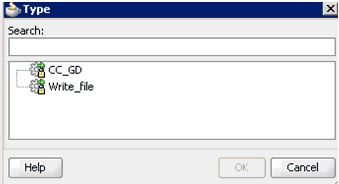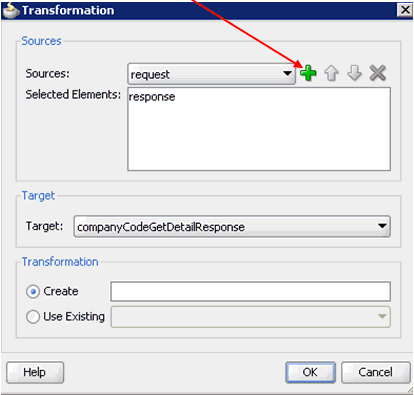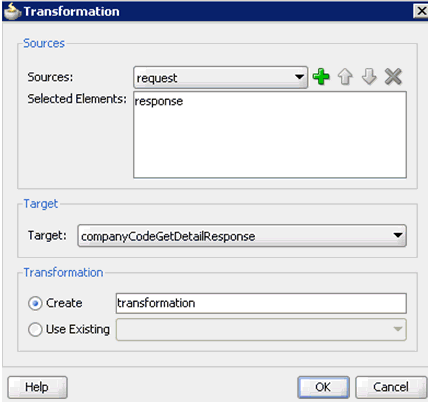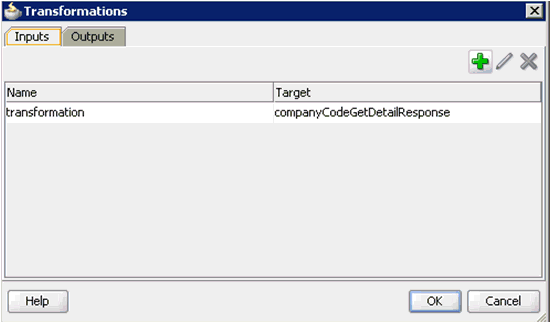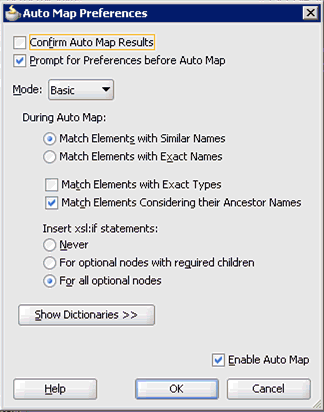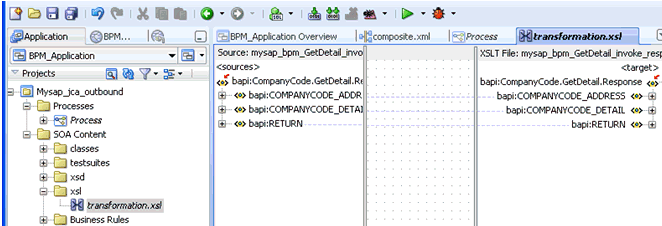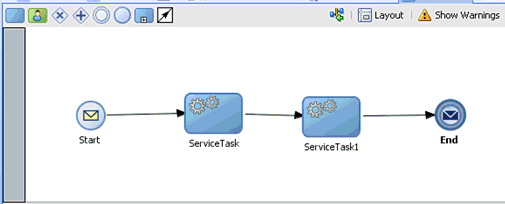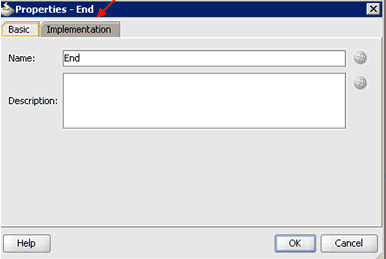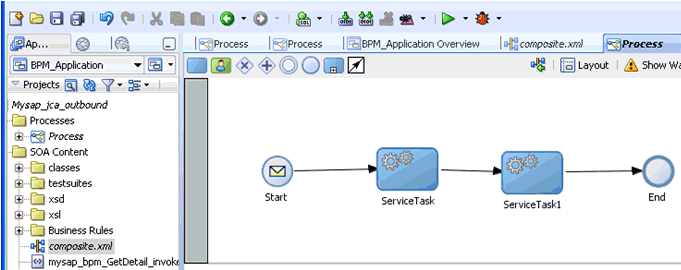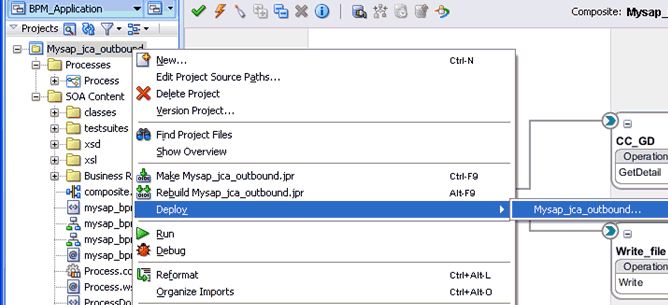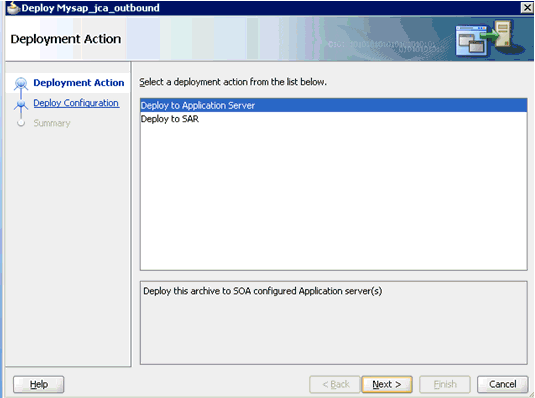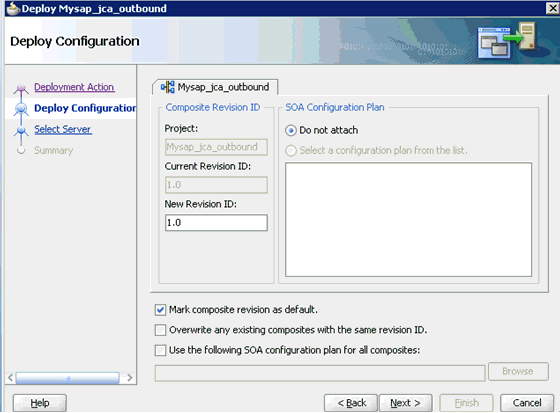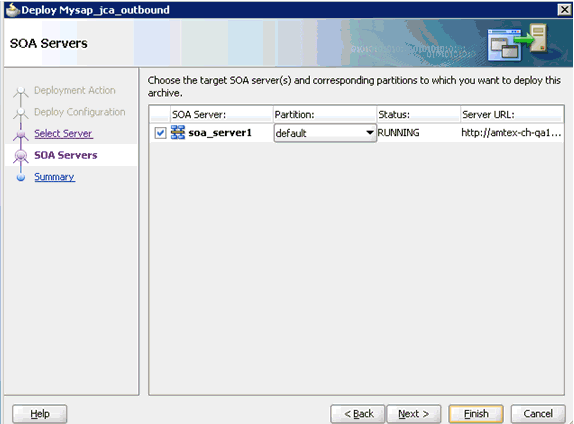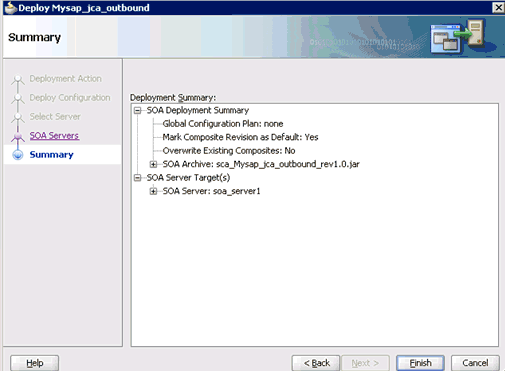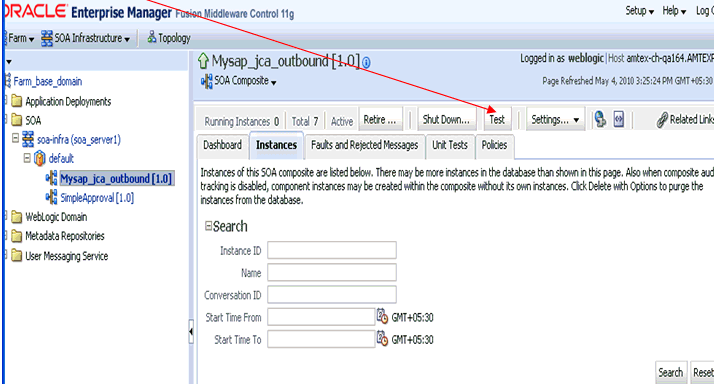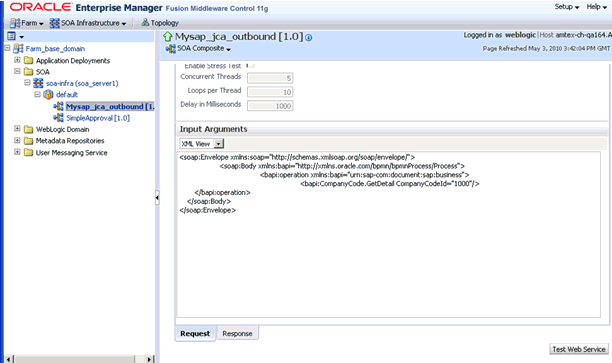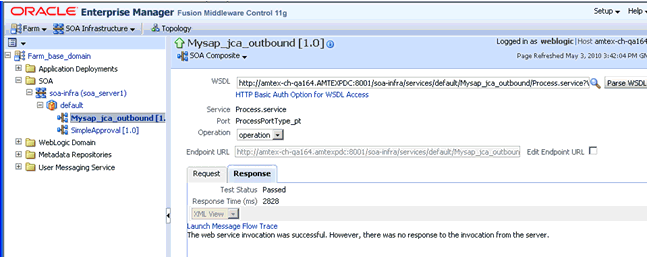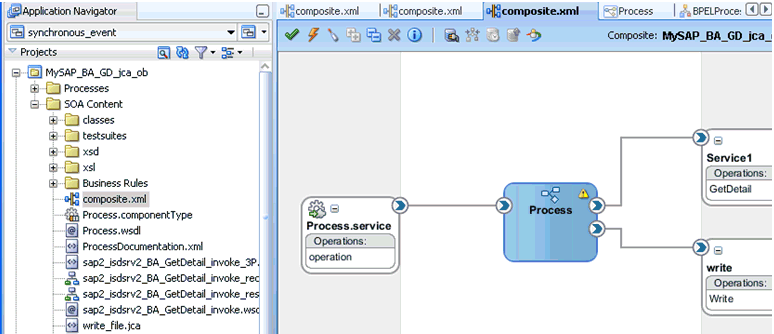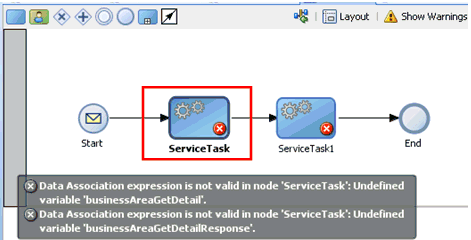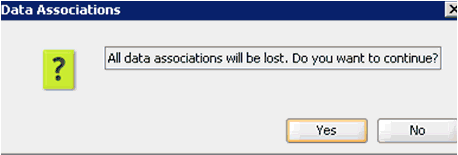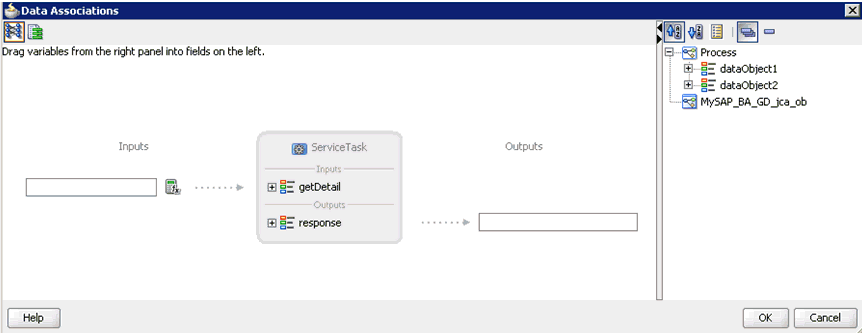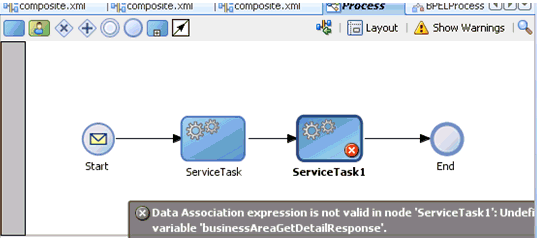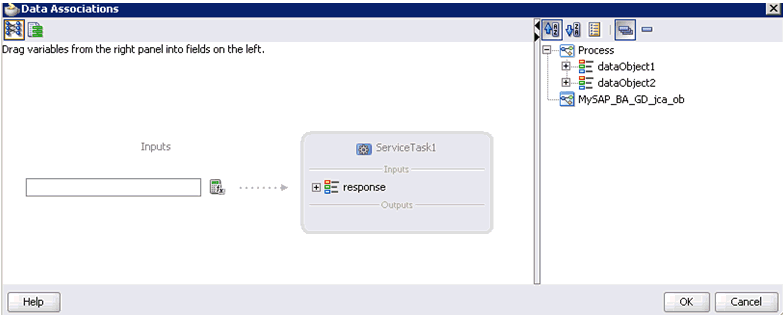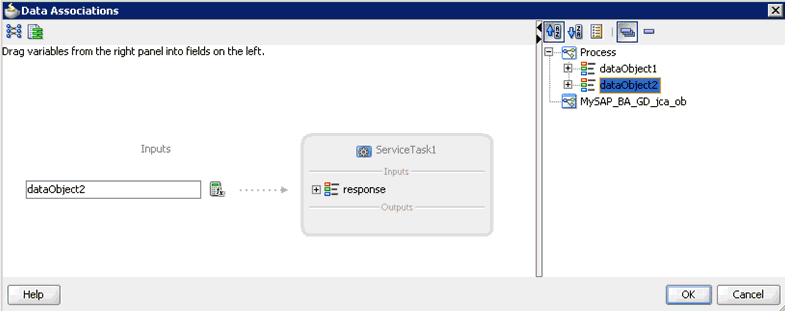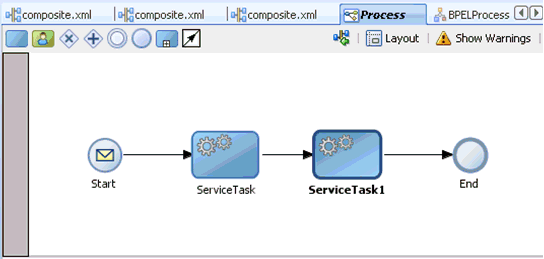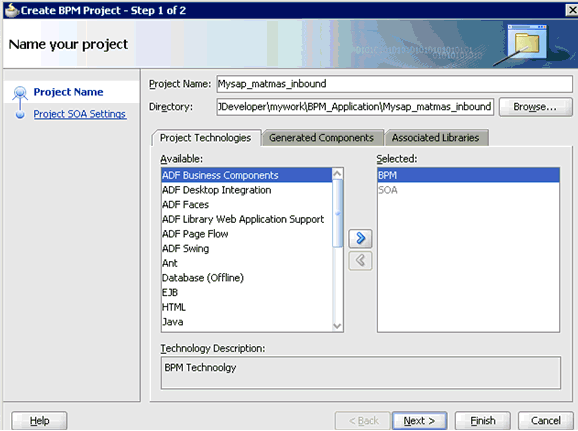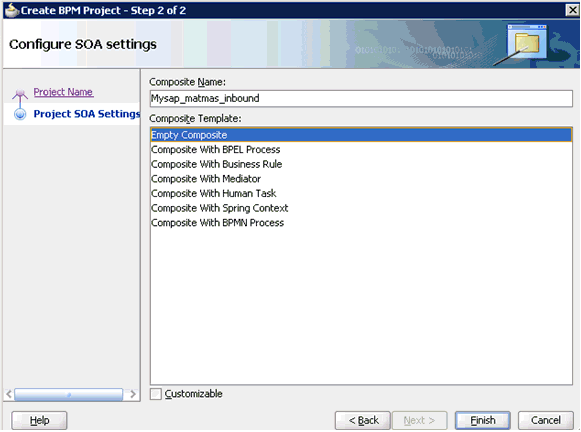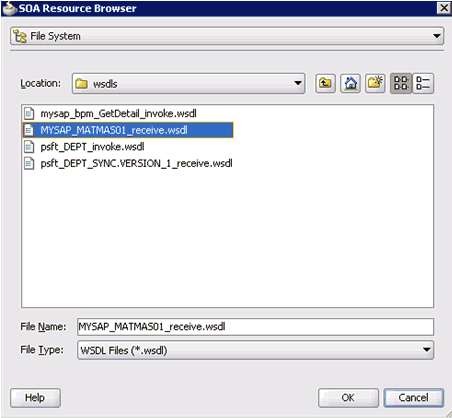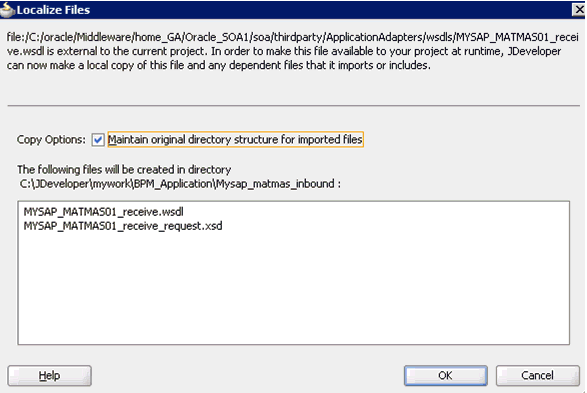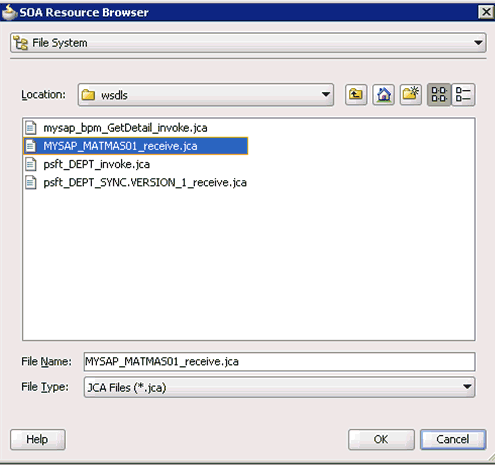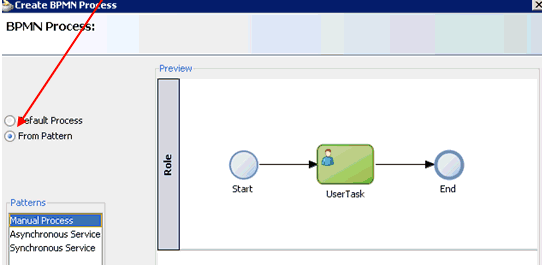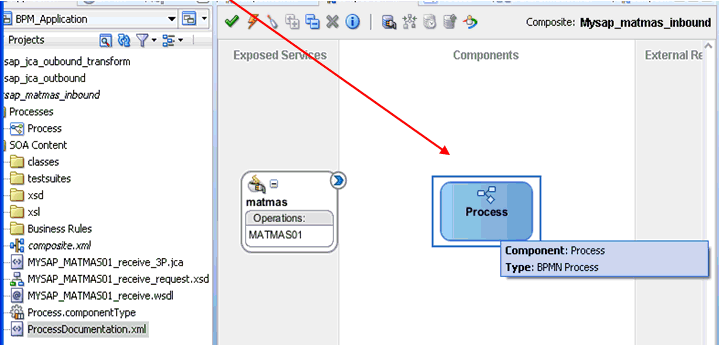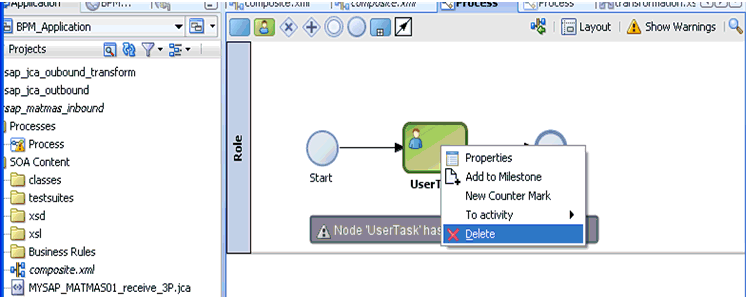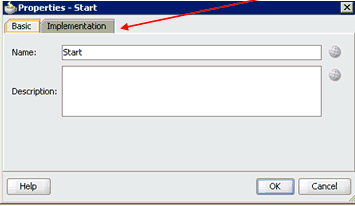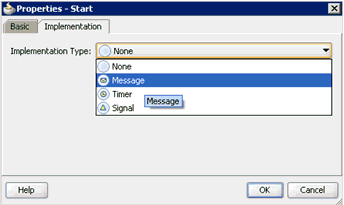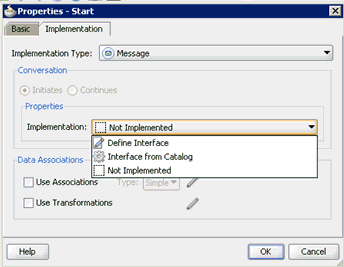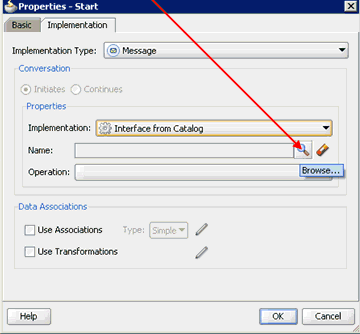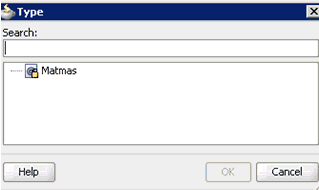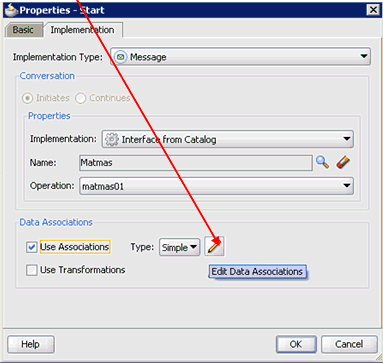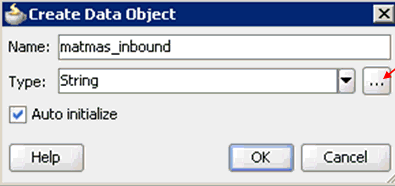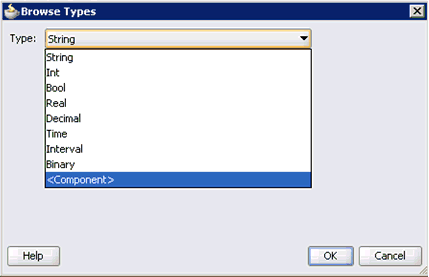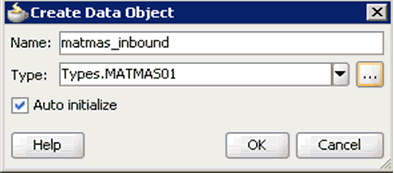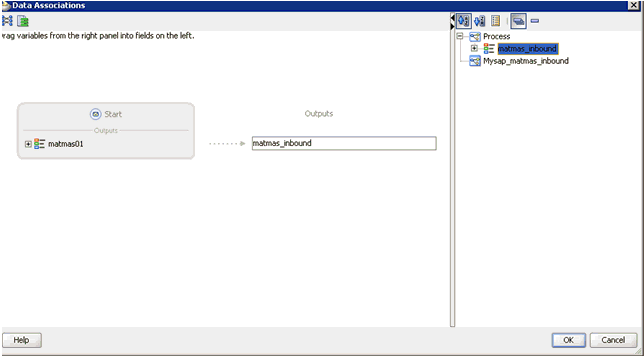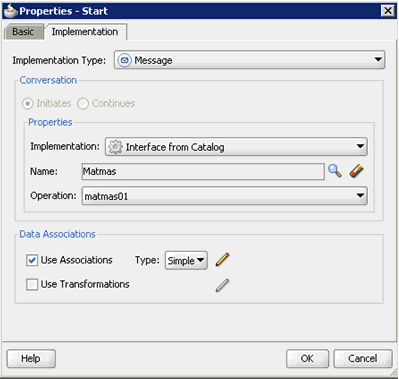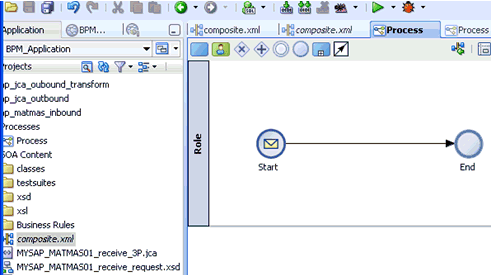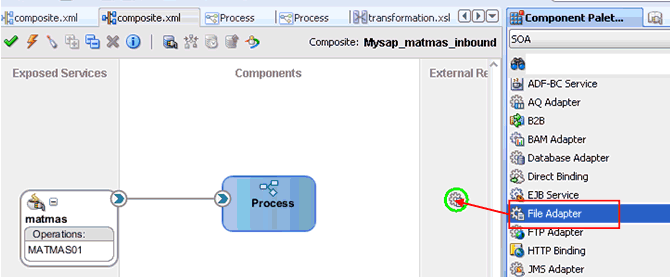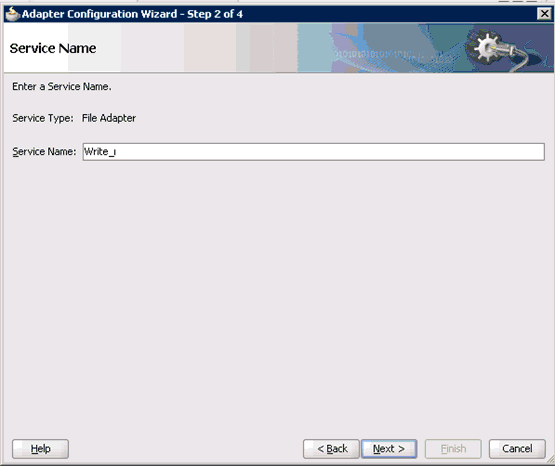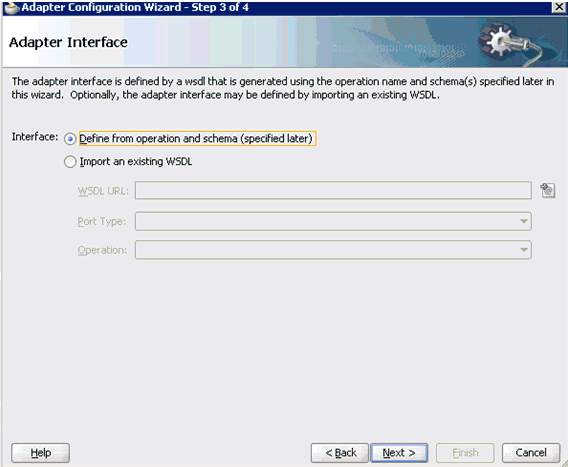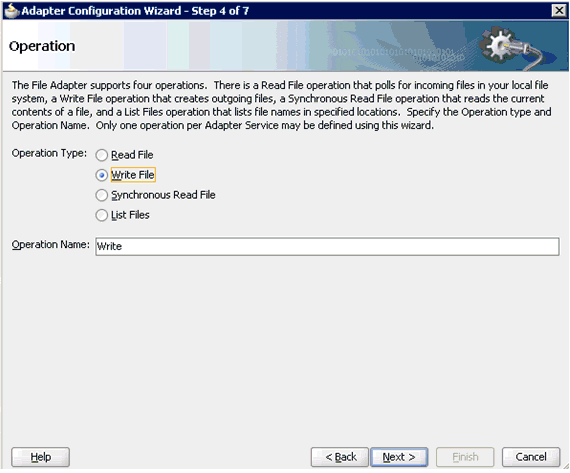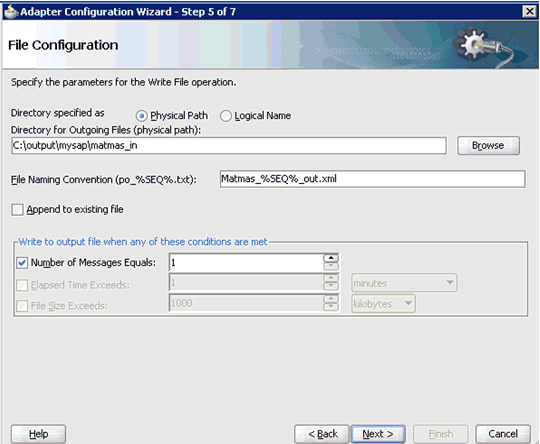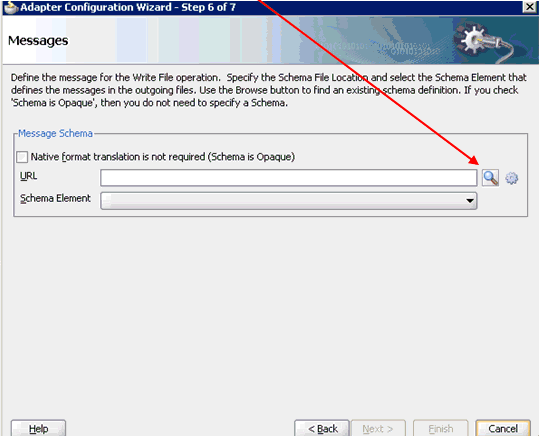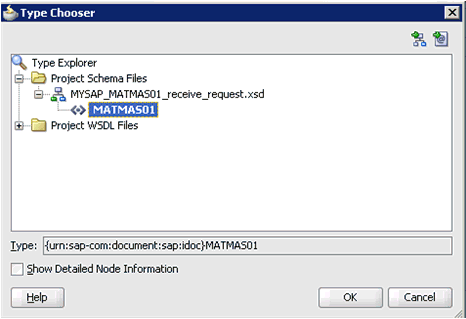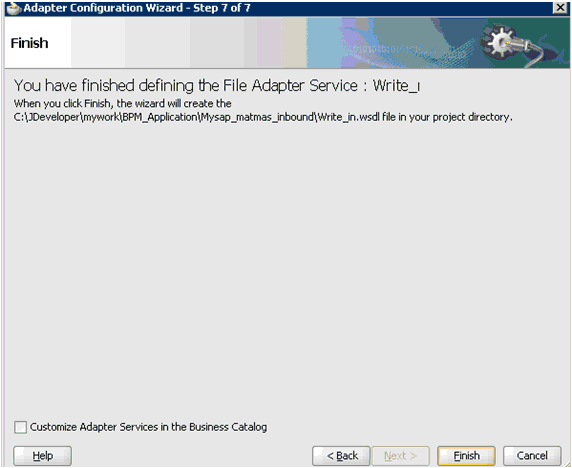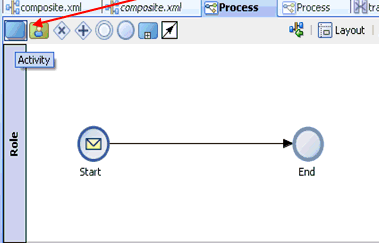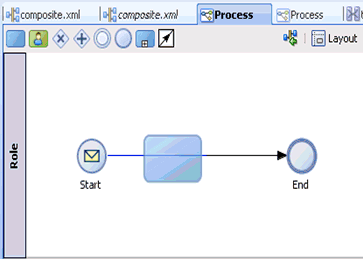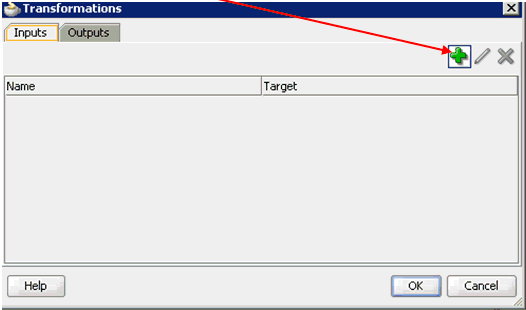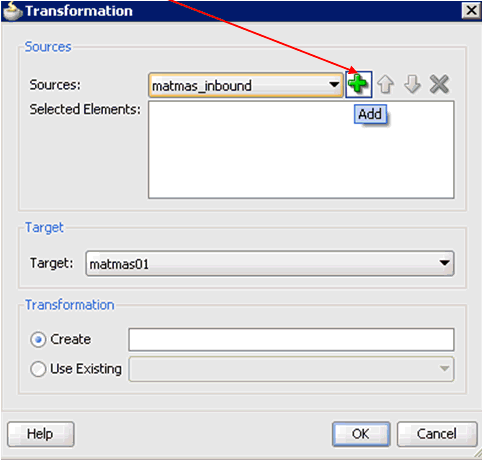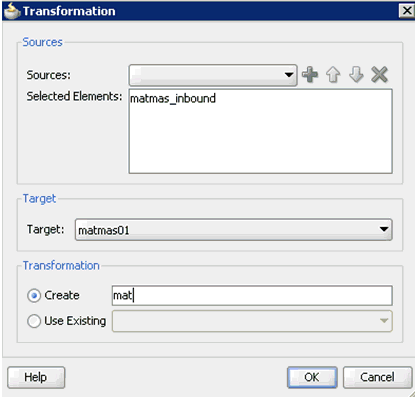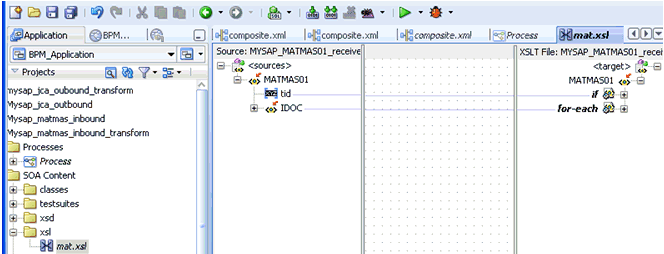8 Integration With BPM Service Components in the Oracle SOA Suite
Oracle Application Adapter for SAP R/3 integrates seamlessly with Business Process Management (BPM) to facilitate Web service integration. Oracle BPM is based on the Service-Oriented Architecture (SOA). It consumes adapter services exposed as Web Service Definition Language (WSDL) documents.
This chapter contains the following topics:
-
Designing an Outbound BPM Process Using Transformations for Service Integration
-
Designing an Inbound BPM Process Using Transformations for Event Integration
Overview
To integrate with Oracle BPM, Oracle Application Adapter for SAP R/3 must be deployed in the same WLS container as Oracle BPM. The underlying adapter services must be exposed as WSDL files, which are generated during design time in Oracle Adapter Application Explorer (Application Explorer) for both request-response (outbound) and event notification (inbound) services of the adapter. For more information, see "Generating WSDL (J2CA Configurations Only)".
The generated WSDL files are used to design the appropriate BPM processes for inbound or outbound adapter services. A completed BPM process must be successfully compiled in JDeveloper and deployed to a BPM server. Upon deployment to the BPM server, every newly built process is automatically deployed to the Oracle Enterprise Manager console, where you run, monitor, and administer BPM processes, and listen to adapter events.
Deployment of Adapter
During installation, Oracle Application Adapter for SAP R/3 is deployed as a J2CA 1.0 resource adapter within the WLS container. The adapter must be deployed in the same WLS container as Oracle BPM.
Configuring a New Application Server Connection
For more information on how to configure a new Application Server connection in Oracle JDeveloper, see Configuring a New Application Server Connection.
Designing an Outbound BPM Process Using Transformations for Service Integration
The following tools are required to complete your outbound design-time configuration:
-
Oracle Adapter Application Explorer (Application Explorer)
-
Oracle JDeveloper BPM Designer (JDeveloper) or Eclipse
Note:
The examples in this chapter demonstrate the use of JDeveloper.Before you design a BPM process, you must generate the respective WSDL file using Application Explorer. For more information, see "Generating WSDL for Request/Response Service".
Creating an Empty Composite for BPM
Perform the following steps to create an empty composite for BPM:
-
Create a new BPM application.
-
Enter a name for the new BPM application and click Next, as shown in Figure 8-1.
The Name your project page is displayed, as shown in Figure 8-2.
-
Enter a project name (for example, Mysap_jca_outbound) and click Next.
The Configure SOA settings page is displayed, as shown in Figure 8-3.
-
From the Composite Template list, select Empty Composite and click Finish.
Defining a BPM Outbound Process
This section describes how to define a BPM outbound process, which consists of the following stages:
-
Configuring a Third Party Adapter Service Component
-
Configuring an Outbound BPM Process Component
-
Creating a File Adapter for the Write Operation
Configuring a Third Party Adapter Service Component
Perform the following steps to create a third party adapter service component:
-
Drag and drop the Third Party Adapter component from the Service Adapters pane to the External References pane, as shown in Figure 8-4.
The Create Third Party Adapter Service dialog is displayed, as shown in Figure 8-5.
Figure 8-5 Create Third Party Adapter Service Dialog
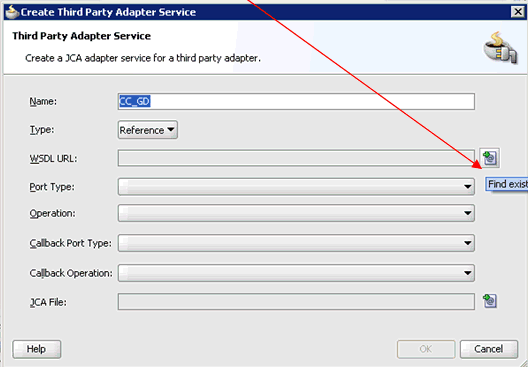
Description of "Figure 8-5 Create Third Party Adapter Service Dialog"
-
Enter a name for the third party adapter service.
-
Ensure that Reference is selected from the Type list (default).
-
Click the Find existing WSDLs icon, which is located to the right of the WSDL URL field.
The SOA Resource Browser dialog is displayed, as shown in Figure 8-6.
-
Browse and select an outbound WSDL file from the following directory:
<ADAPTER_HOME>\soa\thirdparty\ApplicationAdapters\wsdls -
Click OK.
The Localize Files dialog is displayed, as shown in Figure 8-7.
-
Click OK.
The outbound WSDL file and associated request and response XML schema files (.xsd) are imported to the project folder that has been created.
You are returned to the Create Third Party Adapter Service dialog, as shown in Figure 8-8.
Figure 8-8 Create Third Party Adapter Service Dialog
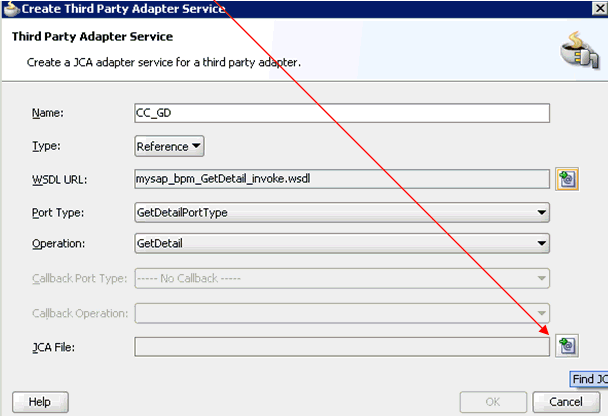
Description of "Figure 8-8 Create Third Party Adapter Service Dialog"
-
Click the Find JCA file icon, which is located to the right of the JCA File field.
The SOA Resource Browser dialog is displayed, as shown in Figure 8-9.
-
Browse and select the JCA properties file from the following directory:
<ADAPTER_HOME>\soa\thirdparty\ApplicationAdapters\wsdls -
Click OK.
The Copy File message is displayed, as shown in Figure 8-10.
Figure 8-10 Copy File Confirmation Message
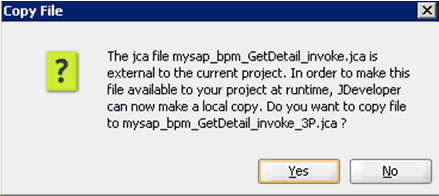
Description of "Figure 8-10 Copy File Confirmation Message"
-
Click Yes.
A copy of the JCA properties file is made in the project folder.
You are returned to the Create Third Party Adapter Service dialog, as shown in Figure 8-11.
Figure 8-11 Create Third Party Adapter Service Dialog

Description of "Figure 8-11 Create Third Party Adapter Service Dialog"
-
Click OK.
The third party adapter service component (CC_GD) is created and displayed in the External References pane, as shown in Figure 8-12.
Figure 8-12 Third Party Adapter Service Component
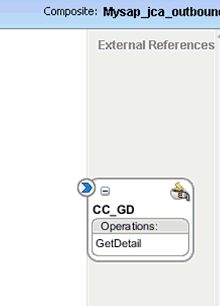
Description of "Figure 8-12 Third Party Adapter Service Component"
You are now ready to configure an outbound BPM process component.
Configuring an Outbound BPM Process Component
Perform the following steps to configure an outbound BPM process component:
-
Drag and drop the BPMN Process component from the Service Components pane to the Components pane, as shown in Figure 8-13.
The Create BPMN Process dialog is displayed, as shown in Figure 8-14.
-
Accept the default option that is selected in the left pane (Default Process) and click Finish.
The BPMN Process component is created, as shown in Figure 8-15.
-
Double-click the BPMN Process component in the Components pane.
The BPMN process is displayed, as shown in Figure 8-16.
-
Click the Activity icon, as shown in Figure 8-17.
-
Drop the Activity icon on the wire between the Start and End event components, as shown in Figure 8-18.
The Properties - Activity dialog is displayed, as shown in Figure 8-19.
-
Click the Implementation tab, as shown in Figure 8-20.
-
Select Service Task from the Implementation Type list, as shown in Figure 8-21.
-
Select Service Call from the Implementation list.
-
Click the Browse icon to the right of the Name field, as shown in Figure 8-22.
The Type dialog is displayed, as shown in Figure 8-23.
-
Select the Third Party Service that has been created and click OK.
You are returned to the Properties - Activity dialog, as shown in Figure 8-24.
-
Select the Use Associations option that is located under Data Associations.
-
Click the Edit Data Associations icon.
The Data Associations dialog is displayed, as shown in Figure 8-25.
-
Right-click the Process node in the right pane and select Add.
The Create Data Object dialog is displayed, as shown in Figure 8-26.
-
Enter a name in the Name field (for example, Request) and click Browse more types to the right of the Type field.
The Browse Types dialog is displayed, as shown in Figure 8-27.
-
Select <Component> from the Type list, as shown in Figure 8-28.
-
Select the first component (for example, CompanyCodeGetDetail) and click OK.
You are returned to the Create Data Object dialog, as shown in Figure 8-29.
-
Click OK.
The Data Object (for example, Request) that has been created is displayed under the Process node in the Data Associations dialog, as shown in Figure 8-30.
-
Create another Data Object by right-clicking the Process node in the right pane and selecting Add, as shown in Figure 8-31.
The Create Data Object dialog is displayed, as shown in Figure 8-32.
-
Enter a name in the Name field (for example, Response) and click Browse more types to the right of the Type field.
The Browse Types dialog is displayed, as shown in Figure 8-33.
-
Select <Component> from the Type list, as shown in Figure 8-34.
-
Select the second component (for example, CompanyCodeGetDetailResponse) and click OK.
You are returned to the Create Data Object dialog, as shown in Figure 8-35.
-
Click OK.
The Data Object (for example, Response) that has been created is displayed under the Process node in the Data Associations dialog, as shown in Figure 8-36.
-
Select the Request Data Object under the Process node in the right pane and drag it to the field below the Inputs area, as shown in Figure 8-37.
-
Select the Response Data Object under the Process node in the right pane and drag it to the field below the Outputs area, as shown in Figure 8-38.
-
Click OK.
You are returned to the Properties - Activity dialog, as shown in Figure 8-39.
-
Click OK.
The Service Task is created between the Start and End Event components, as shown in Figure 8-40.
-
Save the process and double-click the Start event component.
The Properties - Start dialog is displayed, as shown in Figure 8-41.
-
Click the Implementation tab, as shown in Figure 8-42.
-
Click the Plus icon to the right of the Arguments Definition field.
The Create Argument dialog is displayed, as shown in Figure 8-43.
-
Enter a name in the Name field (for example, argument1) and click Browse more types to the right of the Type field.
The Browse Types dialog is displayed, as shown in Figure 8-44.
-
Select <Component> from the Type list, as shown in Figure 8-45.
-
Select the first component (for example, CompanyCodeGetDetail) and click OK.
You are returned to the Create Argument dialog, as shown in Figure 8-46.
-
Click OK.
You are returned to the Properties - Start dialog, as shown in Figure 8-47.
-
Select the Use Associations option that is located under Data Associations.
-
Click the Edit Data Associations icon.
The Data Associations dialog is displayed, as shown in Figure 8-48.
-
Select the Request Data Object under the Process node in the right pane and drag it to the field below the Outputs area.
-
Click OK.
You are returned to the Properties - Activity dialog, as shown in Figure 8-49.
-
Click OK.
You are returned to the Process workspace area, as shown in Figure 8-50.
-
Double-click composite.xml in the left pane.
-
Click the Save All icon in the menu bar to save the new outbound BPM process component that was configured.
You are now ready to create a File adapter for the write operation.
Creating a File Adapter for the Write Operation
Perform the following steps to create a File adapter for the write operation:
-
Drag and drop the File Adapter component from the Service Adapters pane to the External References pane, as shown in Figure 8-51.
The Adapter Configuration Wizard is displayed, as shown in Figure 8-52.
-
Click Next.
The Service Name page is displayed, as shown in Figure 8-53.
-
Type a name for the new File adapter in the Service Name field and click Next.
The Adapter Interface page is displayed, as shown in Figure 8-54.
-
Ensure that the Define from operation and schema (specified later) option is selected.
-
Click Next.
The Operation page is displayed, as shown in Figure 8-55.
-
Select Write File from the list of Operation Type options and specify an Operation Name (for example, Write).
-
Click Next.
The File Configuration page is displayed, as shown in Figure 8-56.
-
Specify a location on your file system where the output file is written.
-
In the File Naming Convention field, specify a name for the output file.
-
Click Next.
The Messages page is displayed, as shown in Figure 8-57.
-
Click Browse, which is located to the right of the URL field.
The Type Chooser dialog is displayed, as shown in Figure 8-58.
-
Expand Project Schema Files and mysap_bpm_GetDetail_invoke_response.xsd.
-
Select the available schema (for example, CompanyCode.GetDetail.Response).
-
Click OK.
You are returned to the Messages page, as shown in Figure 8-59.
-
Click Next.
The Finish page is displayed, as shown in Figure 8-60.
-
Click Finish.
The File Adapter service is created in the External References pane, as shown in Figure 8-61.
-
Double-click the BPMN Process component.
The BPMN process is displayed, as shown in Figure 8-62.
-
Click the Activity icon.
-
Drop the Activity icon on the wire between the Service Task and End event components, as shown in Figure 8-63.
The Properties - Activity dialog is displayed, as shown in Figure 8-64.
-
Click the Implementation tab, as shown in Figure 8-65.
-
Select Service Task from the Implementation Type list, as shown in Figure 8-66.
-
Select Service Call from the Implementation list.
-
Click the Browse icon to the right of the Name field, as shown in Figure 8-67.
The Type dialog is displayed, as shown in Figure 8-68.
-
Select the service for write operation that has been created (for example, Write_file) and click OK.
You are returned to the Properties - ServiceTask1 dialog, as shown in Figure 8-69.
Figure 8-69 Properties - ServiceTask1 Dialog
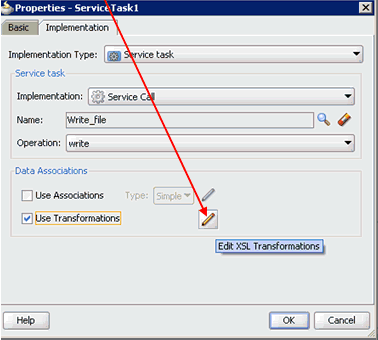
Description of "Figure 8-69 Properties - ServiceTask1 Dialog"
-
Select the Use Transformations option that is located under Data Associations.
-
Click the Edit XSL Transformations icon.
The Transformations dialog is displayed, as shown in Figure 8-70.
-
Click the Plus icon.
The Transformation dialog is displayed, as shown in Figure 8-71.
-
Select the Response Data Object that was created from the Sources list.
-
Click the Plus icon so that the Data Object 'Response' is added to the Selected Elements area, as shown in Figure 8-72.
-
Accept the default value that is selected in the Target list, as shown in Figure 8-73.
-
Enter a name (for example, transformation) in the Create field and click OK.
You are returned to the Transformations dialog, as shown in Figure 8-74.
-
Click OK.
You are returned to the Properties - ServiceTask1 dialog, as shown in Figure 8-75.
Figure 8-75 Properties - ServiceTask1 Dialog
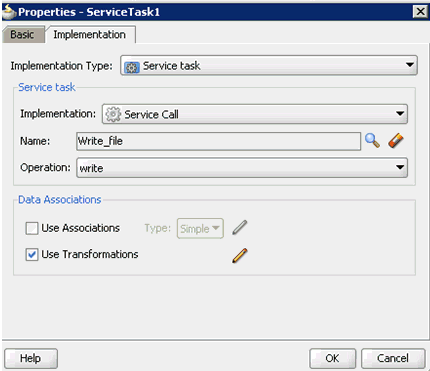
Description of "Figure 8-75 Properties - ServiceTask1 Dialog"
-
Click OK.
The transformation.xsl tab is displayed, as shown in Figure 8-76.
-
Automap the Source and Target elements.
The Auto Map Preferences dialog is displayed, as shown in Figure 8-77.
-
Accept the default values and click OK.
The transformation is completed, as shown in Figure 8-78.
-
Save the transformation.
-
Return to the Process workspace area, as shown in Figure 8-79.
The ServiceTask1 component is created between the ServiceTask component and the End event component.
-
Save the process.
-
Double-click the End event component.
The Properties - End dialog is displayed.
-
Click the Implementation tab, as shown in Figure 8-80.
-
Select None from the Implementation Type list, as shown in Figure 8-81.
-
Click OK.
You are returned to the Process workspace area, as shown in Figure 8-82.
-
Save the Process and double-click the composite.xml file.
-
Click the Save All icon in the menu bar to save the new outbound BPM process component that was configured.
You are now ready to deploy the outbound BPM process.
Deploying the BPM Outbound Process
Perform the following steps to deploy the BPM outbound process.
-
Right-click the project name in the left pane (for example, Mysap_jca_outbound), select Deploy, and then click Mysap_jca_outbound, as shown in Figure 8-83.
The Deployment Action page is displayed, as shown in Figure 8-84.
-
Ensure that Deploy to Application Server is selected.
-
Click Next.
The Deploy Configuration page is displayed, as shown in Figure 8-85.
-
Leave the default values selected and click Next.
The Select Server page is displayed, as shown in Figure 8-86.
-
Select an available application server that was configured and click Next.
The SOA Servers page is displayed, as shown in Figure 8-87.
-
Select a target SOA server and click Next.
The Summary page is displayed, as shown in Figure 8-88.
-
Review and verify all the available deployment information for your project and click Finish.
The process is deployed successfully, as shown in Figure 8-89.
Figure 8-89 Successful Deployment Message

Description of "Figure 8-89 Successful Deployment Message"
Invoking the Input XML Document in the Oracle Enterprise Manager Console
Perform the following steps to invoke the input XML document in the Oracle Enterprise Manager console.
-
Logon to the Oracle Enterprise Manager console, as shown in Figure 8-90.
Figure 8-90 Oracle Enterprise Manager Console
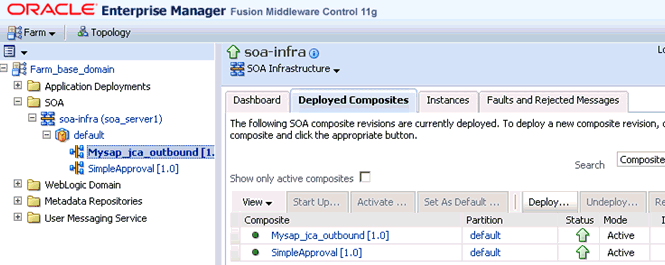
Description of "Figure 8-90 Oracle Enterprise Manager Console"
-
Expand your domain in the left pane followed by the SOA folder.
-
Select an available project (for example, Mysap_jca_outbound).
-
Click Test, as shown in Figure 8-91.
-
Click the Request tab.
-
Provide an appropriate input value in the Value field and click Test Web Service, as shown in Figure 8-92.
A response is received in the Response tab to indicate that invocation was successful in the Oracle Enterprise Manager console, as shown in Figure 8-93.
-
Navigate to the defined output directory on your file system and open the XML response document that was received, as shown in Figure 8-94.
The XML response document contains the generated output with values. For example:
<?xml version="1.0" encoding="UTF-8" ?><bapi:CompanyCode.GetDetail.Response xmlns:bapi="urn:sap-com:document:sap:business.response" xmlns="urn:sap-com:document:sap:business.response"> <bapi:COMPANYCODE_ADDRESS> <bapi:ADDR_NO>0000000121</bapi:ADDR_NO> <bapi:FORMOFADDR>Firma</bapi:FORMOFADDR> <bapi:NAME>Ides AG</bapi:NAME> <bapi:NAME_2/> <bapi:NAME_3/> <bapi:NAME_4/> <bapi:C_O_NAME/> <bapi:CITY>Frankfurt</bapi:CITY> <bapi:DISTRICT/> <bapi:CITY_NO/> <bapi:POSTL_COD1>60441</bapi:POSTL_COD1> <bapi:POSTL_COD2>60070</bapi:POSTL_COD2> <bapi:POSTL_COD3/> <bapi:PO_BOX>160529</bapi:PO_BOX> <bapi:PO_BOX_CIT/> <bapi:DELIV_DIS/> <bapi:STREET>Lyoner Stern 231</bapi:STREET> <bapi:STREET_NO/> <bapi:STR_ABBR/> <bapi:HOUSE_NO/> <bapi:STR_SUPPL1/> <bapi:STR_SUPPL2/> <bapi:LOCATION/> <bapi:BUILDING/> <bapi:FLOOR/> <bapi:ROOM_NO/> <bapi:COUNTRY>DE</bapi:COUNTRY> <bapi:LANGU>D</bapi:LANGU> <bapi:REGION>06</bapi:REGION> <bapi:SORT1>IDES</bapi:SORT1> <bapi:SORT2/> <bapi:TIME_ZONE>CET</bapi:TIME_ZONE> <bapi:TAXJURCODE/> <bapi:ADR_NOTES/> <bapi:COMM_TYPE/> <bapi:TEL1_NUMBR/> <bapi:TEL1_EXT/> <bapi:FAX_NUMBER/> <bapi:FAX_EXTENS/> </bapi:COMPANYCODE_ADDRESS> <bapi:COMPANYCODE_DETAIL> <bapi:COMP_CODE>1000</bapi:COMP_CODE> <bapi:COMP_NAME>IDES AG</bapi:COMP_NAME> <bapi:CITY>Frankfurt</bapi:CITY> <bapi:COUNTRY>DE</bapi:COUNTRY> <bapi:CURRENCY>EUR</bapi:CURRENCY> <bapi:LANGU>D</bapi:LANGU> <bapi:CHRT_ACCTS>INT</bapi:CHRT_ACCTS> <bapi:FY_VARIANT>K4</bapi:FY_VARIANT> <bapi:VAT_REG_NO>DE123456789</bapi:VAT_REG_NO> <bapi:COMPANY>001000</bapi:COMPANY> <bapi:ADDR_NO>0000000121</bapi:ADDR_NO> <bapi:COUNTRY_ISO>DE</bapi:COUNTRY_ISO> <bapi:CURRENCY_ISO>EUR</bapi:CURRENCY_ISO> <bapi:LANGU_ISO>DE</bapi:LANGU_ISO> </bapi:COMPANYCODE_DETAIL> <bapi:RETURN> <bapi:TYPE/> <bapi:CODE/> <bapi:MESSAGE/> <bapi:LOG_NO/> <bapi:LOG_MSG_NO>000000</bapi:LOG_MSG_NO> <bapi:MESSAGE_V1/> <bapi:MESSAGE_V2/> <bapi:MESSAGE_V3/> <bapi:MESSAGE_V4/> </bapi:RETURN></bapi:CompanyCode.GetDetail.Response>
Workaround for J2CA BPM Processing When Using BAPI or RFC Objects
When a J2CA BPM outbound process for the BusinessArea GetDetail object is created and deployed, the following error is generated in Oracle JDeveloper:
Error: Data Association expression is not valid in node 'ServiceTask': Undefined variable 'businessAreaGetDetail'. Error: Data Association expression is not valid in node 'ServiceTask': Undefined variable 'businessAreaGetDetailResponse'. Error: The transformation in node ServiceTask1 has an invalid target reference: businessAreaGetDetailResponse
This section provides instructions on how to apply a workaround that resolves this issue.
Note:
This workaround is applicable to Oracle BUG 10078610 - typeloadruntimeexception: bpm-71530 using xsd with attribute group.-
Close and then reopen Oracle JDeveloper.
-
Open the
composite.xmlfile from the project folder and double-click the Process component, as shown in Figure 8-95.The Process tab is displayed.
-
Double-click the ServiceTask activity, as shown in Figure 8-96.
The Properties - ServiceTask dialog is displayed, as shown in Figure 8-97.
Figure 8-97 Properties - ServiceTask Dialog
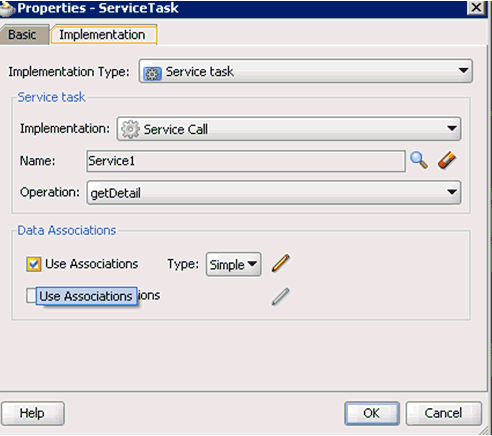
Description of "Figure 8-97 Properties - ServiceTask Dialog"
-
Click the Implementation tab.
-
Uncheck the Use Associations option.
A confirmation message is displayed in the Data Associations dialog, as shown in Figure 8-98.
-
Click Yes.
You are returned to the Properties - ServiceTask dialog, as shown in Figure 8-99.
Figure 8-99 Properties - ServiceTask Dialog

Description of "Figure 8-99 Properties - ServiceTask Dialog"
-
Select the Use Associations option and then click the Edit Data Associations icon.
The Data Associations window is displayed, as shown in Figure 8-100.
-
Drag and drop dataobject1 (request) to the Inputs field and dataobject2 (response) to the Outputs field, as shown in Figure 8-101.
Figure 8-101 Dataobject1 and Dataobject 2
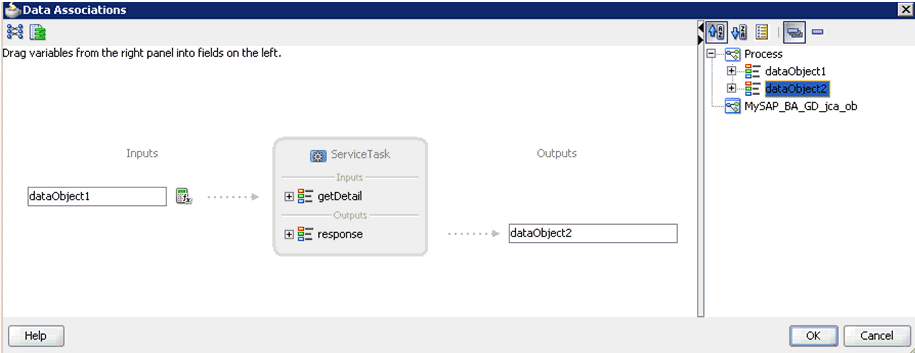
Description of "Figure 8-101 Dataobject1 and Dataobject 2"
-
Click OK.
You are returned to the Properties - ServiceTask dialog, as shown in Figure 8-102.
Figure 8-102 Properties - ServiceTask Dialog
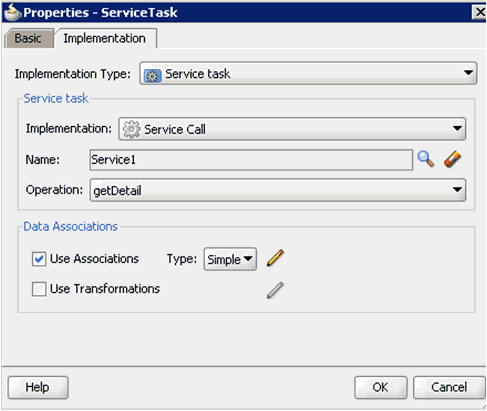
Description of "Figure 8-102 Properties - ServiceTask Dialog"
-
Click OK.
You are returned to the Process tab, as shown in Figure 8-103.
-
Double-click the ServiceTask1 activity.
The Properties - ServiceTask1 dialog is displayed, as shown in Figure 8-104.
Figure 8-104 Properties - ServiceTask1 Dialog
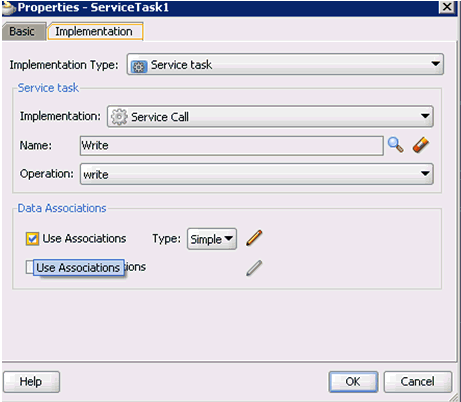
Description of "Figure 8-104 Properties - ServiceTask1 Dialog"
-
Click the Implementation tab.
-
Uncheck the Use Associations option.
A confirmation message is displayed in the Data Associations dialog, as shown in Figure 8-105.
-
Click Yes.
You are returned to the Properties - ServiceTask1 dialog, as shown in Figure 8-106.
Figure 8-106 Properties - ServiceTask1 Dialog
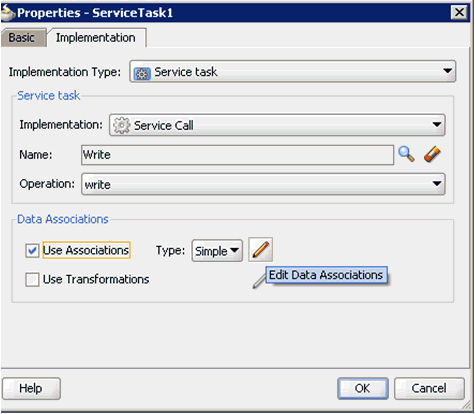
Description of "Figure 8-106 Properties - ServiceTask1 Dialog"
-
Select the Use Associations option and then click the Edit Data Associations icon.
The Data Associations window is displayed, as shown in Figure 8-107.
-
Drag and drop dataobject2 (response) to the Inputs field, as shown in Figure 8-108.
-
Click OK.
You are returned to the Properties - ServiceTask1 dialog, as shown in Figure 8-109.
Figure 8-109 Properties - ServiceTask1 Dialog
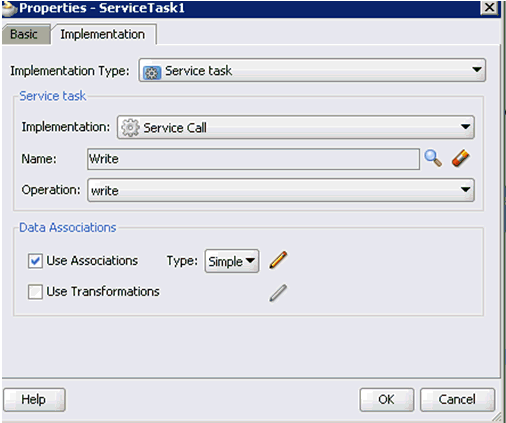
Description of "Figure 8-109 Properties - ServiceTask1 Dialog"
-
Click OK.
You are returned to the Process tab, as shown in Figure 8-110.
Notice that no errors or warnings are being indicated.
-
Save the process and then deploy the process.
Designing an Inbound BPM Process Using Transformations for Event Integration
This section demonstrates how Oracle Application Adapter for SAP R/3 integrates with SAP R/3 to receive event data.
The following tools are required to complete your adapter design-time configuration:
-
Oracle Adapter Application Explorer (Application Explorer)
-
Oracle JDeveloper BPM Designer (JDeveloper) or Eclipse
Note:
The examples in this chapter demonstrate the use of JDeveloper.Before you design a BPM process, you must generate the respective WSDL file using Application Explorer. For more information, see "Generating WSDL for Event Integration".
Creating an Empty Composite for BPM
Perform the following steps to create an empty composite for BPM:
-
Create a new BPM application.
-
Enter a name for the new BPM application and click Next, as shown in Figure 8-111.
The Name your project page is displayed, as shown in Figure 8-112.
-
Enter a project name (for example, Mysap_matmas_inbound) and click Next.
The Configure SOA settings page is displayed, as shown in Figure 8-113.
-
From the Composite Template list, select Empty Composite and click Finish.
Defining a BPM Inbound Process
This section describes how to define a BPM inbound process, which consists of the following stages:
-
Configuring a Third Party Adapter Service Component
-
Configuring an Inbound BPM Process Component
-
Creating a File Adapter for the Write Operation
Configuring a Third Party Adapter Service Component
Perform the following steps to create a third party adapter service component:
-
Drag and drop the Third Party Adapter component from the Service Adapters pane to the Exposed References pane, as shown in Figure 8-114.
Figure 8-114 Third Party Adapter Component
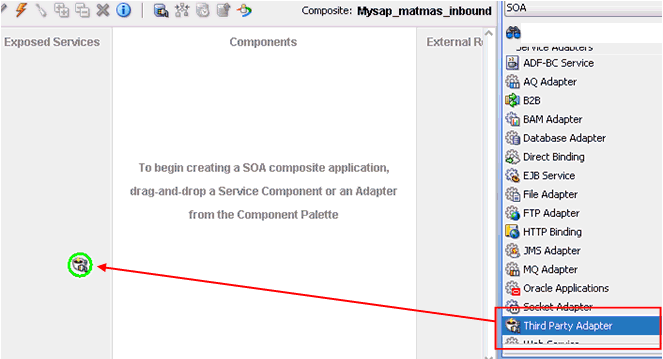
Description of "Figure 8-114 Third Party Adapter Component"
The Create Third Party Adapter Service dialog is displayed, as shown in Figure 8-115.
Figure 8-115 Create Third Party Adapter Service Dialog
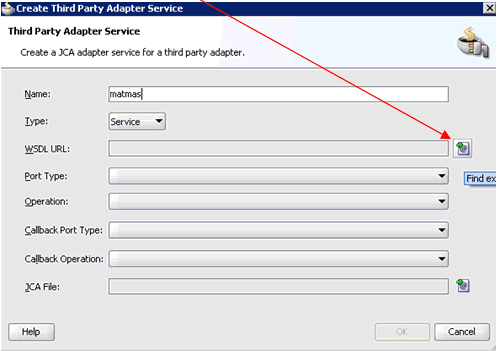
Description of "Figure 8-115 Create Third Party Adapter Service Dialog"
-
Enter a name for the third party adapter service.
-
Ensure that Service is selected from the Type list (default).
-
Click the Find existing WSDLs icon, which is located to the right of the WSDL URL field.
The SOA Resource Browser dialog is displayed, as shown in Figure 8-116.
-
Browse and select an inbound WSDL file from the following directory:
<ADAPTER_HOME>\soa\thirdparty\ApplicationAdapters\wsdls -
Click OK.
The Localize Files dialog is displayed, as shown in Figure 8-117.
-
Click OK.
The inbound WSDL file and associated receive_request XML schema file (.xsd) are imported to the project folder that has been created.
You are returned to the Create Third Party Adapter Service dialog, as shown in Figure 8-118.
Figure 8-118 Create Third Party Adapter Service Dialog
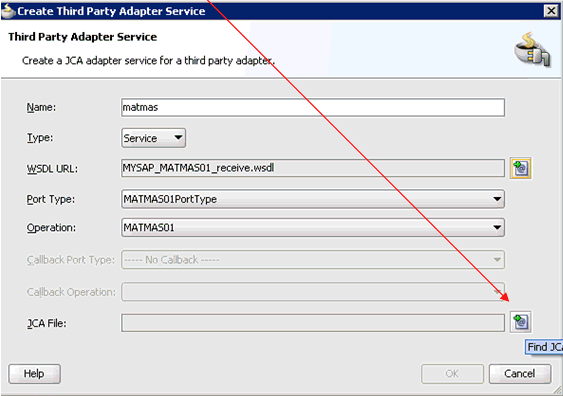
Description of "Figure 8-118 Create Third Party Adapter Service Dialog"
-
Click the Find JCA file icon, which is located to the right of the JCA File field.
The SOA Resource Browser dialog is displayed, as shown in Figure 8-119.
-
Browse and select the JCA properties file from the following directory:
<ADAPTER_HOME>\soa\thirdparty\ApplicationAdapters\wsdls -
Click OK.
The Copy File message is displayed, as shown in Figure 8-120.
Figure 8-120 Copy File Confirmaton Message

Description of "Figure 8-120 Copy File Confirmaton Message"
-
Click Yes.
A copy of the JCA properties file is made in the project folder.
You are returned to the Create Third Party Adapter Service dialog, as shown in Figure 8-121.
Figure 8-121 Create Third Party Adapter Service Dialog
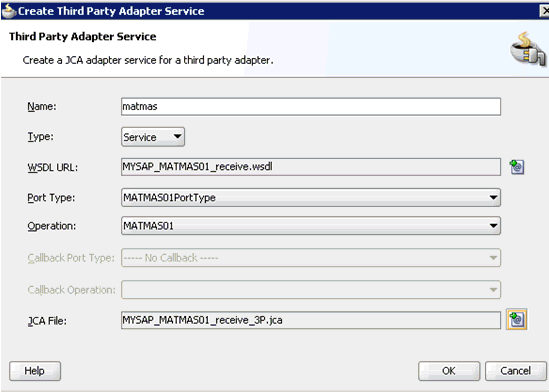
Description of "Figure 8-121 Create Third Party Adapter Service Dialog"
-
Click OK.
The third party adapter service component (matmas) is created in the Exposed References pane, as shown in Figure 8-122.
Figure 8-122 Third Party Adapter Service Component

Description of "Figure 8-122 Third Party Adapter Service Component"
You are now ready to configure an inbound BPM process component.
Configuring an Inbound BPM Process Component
Perform the following steps to configure an inbound BPM process component:
-
Drag and drop the BPMN Process component from the Service Components pane to the Components pane, as shown in Figure 8-123.
The Create BPMN Process dialog is displayed, as shown in Figure 8-124.
-
Select the From Pattern option in the left pane and ensure that Manual Process is selected in the Patterns area.
-
Click Finish.
The BPMN Process component is created, as shown in Figure 8-125.
-
Double-click the BPMN Process component in the Components pane.
The BPMN process is displayed, as shown in Figure 8-126.
-
Right-click UserTask and select Delete from the menu.
-
Double-click the Start event component, as shown in Figure 8-127.
The Properties - Start dialog is displayed, as shown in Figure 8-128.
-
Click the Implementation tab, as shown in Figure 8-129.
-
Select Message from the Implementation Type list, as shown in Figure 8-130.
-
Select Interface from Catalog from the Implementation list.
-
Click the Browse icon to the right of the Name field, as shown in Figure 8-131.
The Type dialog is displayed, as shown in Figure 8-132.
-
Select the Third Party Service that has been created and click OK.
You are returned to the Properties - Start dialog, as shown in Figure 8-133.
-
Select the Use Associations option that is located under Data Associations.
-
Click the Edit Data Associations icon.
The Data Associations dialog is displayed, as shown in Figure 8-134.
-
Right-click the Process node in the right pane and select Add.
The Create Data Object dialog is displayed, as shown in Figure 8-135.
-
Enter a name in the Name field (for example, matmas_inbound) and click Browse more types to the right of the Type field.
The Browse Types dialog is displayed, as shown in Figure 8-136.
-
Select <Component> from the Type list, as shown in Figure 8-137.
-
Select the first component (for example, MATMAS01) and click OK.
You are returned to the Create Data Object dialog, as shown in Figure 8-138.
-
Click OK.
The Data Object (for example, matmas_inbound) that has been created is displayed under the Process node in the Data Associations dialog, as shown in Figure 8-139.
-
Select the matmas_inbound Data Object under the Process node in the right pane and drag it to the field below the Outputs area.
-
Click OK.
You are returned to the Properties - Start dialog, as shown in Figure 8-140.
-
Click OK.
You are returned to the Process workspace area, as shown in Figure 8-141.
-
Double-click composite.xml in the left pane.
-
Click the Save All icon in the menu bar to save the new inbound BPM process component that was configured.
You are now ready to create a File adapter for the write operation.
Creating a File Adapter for the Write Operation
Perform the following steps to create a File adapter for the write operation:
-
Drag and drop the File Adapter component from the Service Adapters pane to the External References pane, as shown in Figure 8-142.
The Adapter Configuration Wizard is displayed, as shown in Figure 8-143.
Figure 8-143 Adapter Configuration Wizard
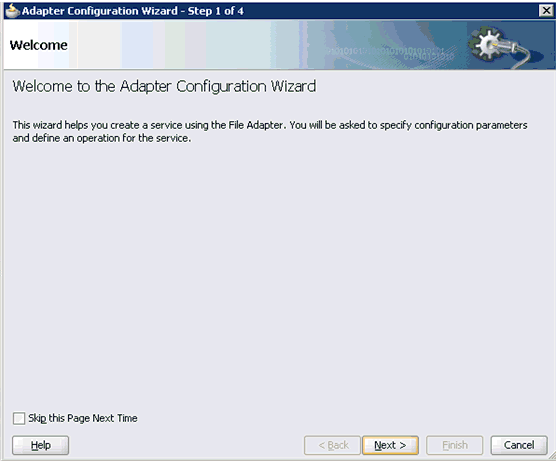
Description of "Figure 8-143 Adapter Configuration Wizard"
-
Click Next.
The Service Name page is displayed, as shown in Figure 8-144.
-
Type a name for the new File adapter in the Service Name field and click Next.
The Adapter Interface page is displayed, as shown in Figure 8-145.
-
Ensure that the Define from operation and schema (specified later) option is selected.
-
Click Next.
The Operation page is displayed, as shown in Figure 8-146.
-
Select Write File from the list of Operation Type options and specify an Operation Name (for example, Write).
-
Click Next.
The File Configuration page is displayed, as shown in Figure 8-147.
-
Specify a location on your file system where the output file is written.
-
In the File Naming Convention field, specify a name for the output file.
-
Click Next.
The Messages page is displayed, as shown in Figure 8-148.
-
Click Browse, which is located to the right of the URL field.
The Type Chooser dialog is displayed, as shown in Figure 8-149.
-
Expand Project Schema Files and MYSAP_MATMAS01_receive_request.xsd.
-
Select the available schema (for example, MATMAS01).
-
Click OK.
You are returned to the Messages page, as shown in Figure 8-150.
-
Click Next.
The Finish page is displayed, as shown in Figure 8-151.
-
Click Finish.
The File Adapter service is created in the External References pane, as shown in Figure 8-152.
-
Double-click the BPMN Process component.
The BPMN process is displayed, as shown in Figure 8-153.
-
Click the Activity icon.
-
Drop the Activity icon on the wire between the Start and End event components, as shown in Figure 8-154.
The Properties - Activity dialog is displayed, as shown in Figure 8-155.
Figure 8-155 Properties - Activity Dialog
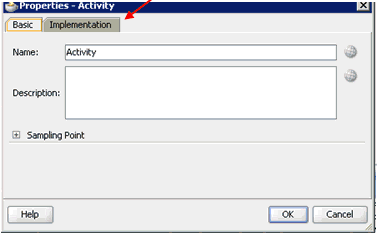
Description of "Figure 8-155 Properties - Activity Dialog"
-
Click the Implementation tab, as shown in Figure 8-156.
-
Select Service Task from the Implementation Type list, as shown in Figure 8-157.
-
Select Service Call from the Implementation list.
-
Click the Browse icon to the right of the Name field, as shown in Figure 8-158.
The Type dialog is displayed, as shown in Figure 8-159.
-
Select the service for write operation that has been created and click OK.
You are returned to the Properties - Activity dialog, as shown in Figure 8-160.
Figure 8-160 Properties - Activity Dialog
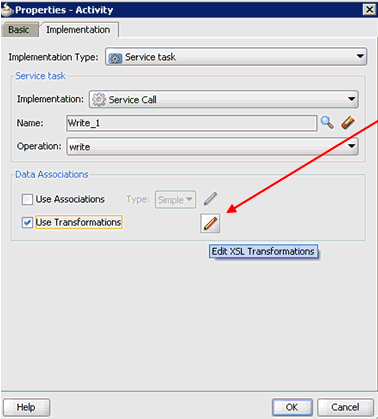
Description of "Figure 8-160 Properties - Activity Dialog"
-
Select the Use Transformations option that is located under Data Associations.
-
Click the Edit XSL Transformations icon.
The Transformations dialog is displayed, as shown in Figure 8-161.
-
Click the Plus icon.
The Transformation dialog is displayed, as shown in Figure 8-162.
-
Select the matmas_inbound Data Object that was created from the Sources list.
-
Click the Plus icon so that the Data Object 'matmas_inbound' is added to the Selected Elements area.
-
Accept the default value that is selected in the Target list, as shown in Figure 8-163.
-
Enter a name (for example, mat) in the Create field and click OK, as shown in Figure 8-164.
You are returned to the Transformations dialog, as shown in Figure 8-165.
-
Click OK.
You are returned to the Properties - Activity dialog, as shown in Figure 8-166.
Figure 8-166 Properties - Activity Dialog

Description of "Figure 8-166 Properties - Activity Dialog"
-
Click OK.
The mat.xsl tab is displayed, as shown in Figure 8-167.
-
Automap the Source and Target elements.
The Auto Map Preferences dialog is displayed, as shown in Figure 8-168.
-
Accept the default values and click OK.
The transformation is completed, as shown in Figure 8-169.
-
Save the transformation.
-
Return to the Process workspace area, as shown in Figure 8-170.
The ServiceTask component is created between the Start event component and the End event component.
-
Save the Process and double-click the composite.xml file.
-
Click the Save All icon in the menu bar to save the new inbound BPM process component that was configured.
You are now ready to deploy the inbound BPM process. You can follow the same procedure that is described in "Deploying the BPEL Inbound Process". For more information on how to trigger events in SAP R/3, see "Triggering an Event in SAP R/3".
